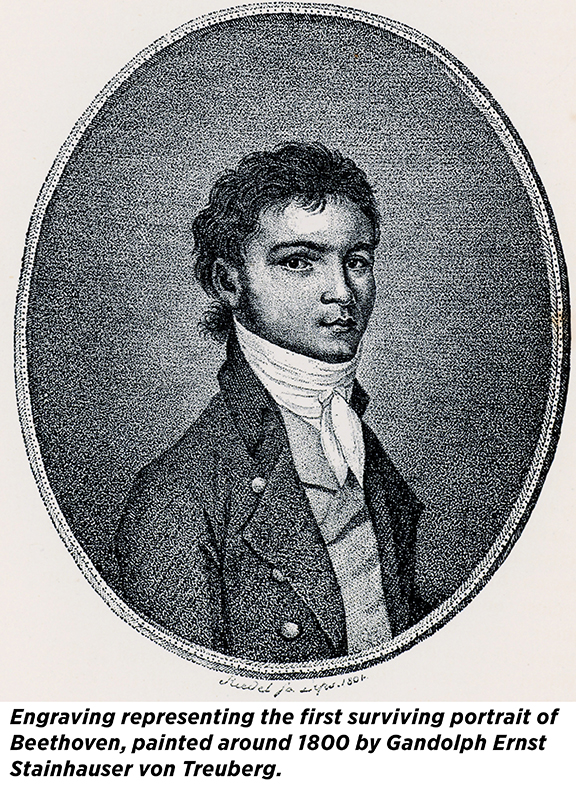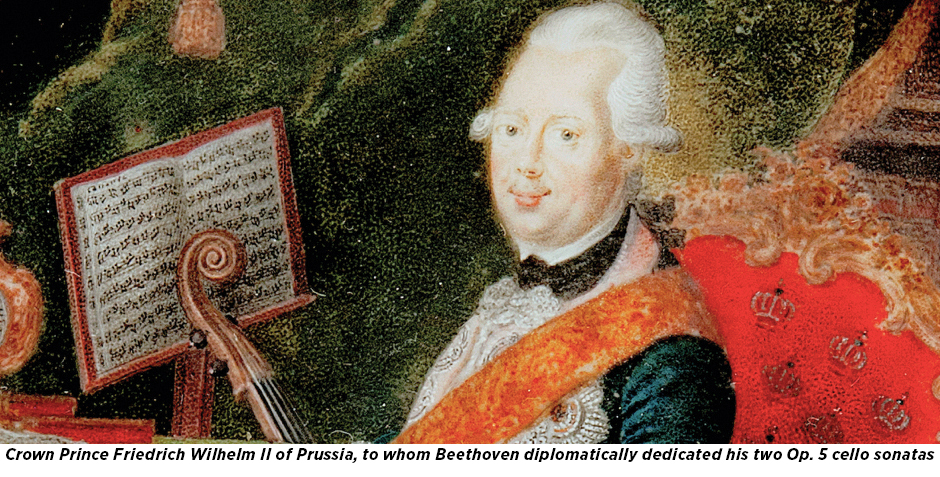*Due to the late change in the program of the first two pieces, the program notes reflect the original works.*
Composed 1815; 21 minutes
 Beethoven wrote his five cello sonatas when advances were being made in both string and keyboard technique and design. He was a key player in the development of both the violin and cello duo sonatas, working with few prior models. Beethoven, along with Haydn, Mozart and Boccherini, also favored the cello in certain chamber works. There was a reason for this: they all visited a culturally rich court where a sure way of securing the King’s attention was to write cello music for his pleasure.
Beethoven wrote his five cello sonatas when advances were being made in both string and keyboard technique and design. He was a key player in the development of both the violin and cello duo sonatas, working with few prior models. Beethoven, along with Haydn, Mozart and Boccherini, also favored the cello in certain chamber works. There was a reason for this: they all visited a culturally rich court where a sure way of securing the King’s attention was to write cello music for his pleasure.
 In 1786, Crown Prince Friedrich Wilhelm II inherited a splendid tradition of music-making at the Prussian court. He himself was a cellist of some accomplishment and enjoyed playing string quartets. The 26-year-old Beethoven made his way to Berlin in the early summer of 1796 and composed the two Op. 5 cello sonatas and two sets of variations for the brother of Wilhelm II’s principal cellist, Jean-Pierre Duport. Younger brother Jean-Louis Duport (1749-1819) was regarded as the leading virtuoso cellist of the day and he remained at the Berlin court 1790-c.1807, fleeing the French Revolution and subsequent politics. Jean-Louis later codified his own advances in cello technique and those of his elder brother, essentially laying the foundation of present-day cello playing. The wealth of cello expertise and the personality of the Duport brothers had a decisive impact on the way Beethoven wrote his first two sonatas. Jean-Louis did for the cello what his friend Giovanni Viotti was doing at the same time in France for the violin. Both virtuosos turned their attention to matters of sustaining power, articulation and emotional expression, in addition to new bowing techniques and the nimble use of left-hand finger technique that had been favored by earlier composers for their respective instruments. Beethoven quickly absorbed what they had to offer to the degree that some aspects of his writing for cello in his five sonatas found a place in Jean-Louis’ tutor for the instrument of 1806.
In 1786, Crown Prince Friedrich Wilhelm II inherited a splendid tradition of music-making at the Prussian court. He himself was a cellist of some accomplishment and enjoyed playing string quartets. The 26-year-old Beethoven made his way to Berlin in the early summer of 1796 and composed the two Op. 5 cello sonatas and two sets of variations for the brother of Wilhelm II’s principal cellist, Jean-Pierre Duport. Younger brother Jean-Louis Duport (1749-1819) was regarded as the leading virtuoso cellist of the day and he remained at the Berlin court 1790-c.1807, fleeing the French Revolution and subsequent politics. Jean-Louis later codified his own advances in cello technique and those of his elder brother, essentially laying the foundation of present-day cello playing. The wealth of cello expertise and the personality of the Duport brothers had a decisive impact on the way Beethoven wrote his first two sonatas. Jean-Louis did for the cello what his friend Giovanni Viotti was doing at the same time in France for the violin. Both virtuosos turned their attention to matters of sustaining power, articulation and emotional expression, in addition to new bowing techniques and the nimble use of left-hand finger technique that had been favored by earlier composers for their respective instruments. Beethoven quickly absorbed what they had to offer to the degree that some aspects of his writing for cello in his five sonatas found a place in Jean-Louis’ tutor for the instrument of 1806.
The two-movement structure of the First Sonata, in F major, Op. 5 No. 1 and its companion likely resulted from Beethoven’s reluctance to write a full-scale slow movement for piano and cello. (Of all the five sonatas, only the last includes a full slow movement.) Instead, he provides a weighty, slow introduction which leads to an extended opening movement. This is full of themes of varying character, presented in turn by each of the instruments, much as in a Mozart concerto movement. In addition to bringing the full arsenal of his piano technique to bear on the sonata, Beethoven also develops a feasible partnership with the cello. There’s even a 38-measure written-out cadenza for the two instruments. Beethoven incorporates a variety of cello techniques including double stops, occasional chords, pizzicato notes, arpeggios and passages in broken octaves, making his cello writing richer and bolder than ever before in his chamber music. The finale is a lively rondo, which often gives virtuoso display to the piano.
Two decades later, the inspiration for writing his Fourth and the Fifth Sonata in D major, Op. 102 No. 2 came from Beethoven’s friend Josef Linke, cellist in the Razumovsky and, later, the Schuppanzigh Quartets, two string quartets with whom Beethoven worked closely. The element of fantasy in both sonatas puzzled early audiences. After hearing Linke perform one of them with the pianist Carl Czerny, Michael Frey, a leading Mannheim musician, wrote in his diary: “It is so original that no one can understand it on first hearing.” The two sonatas are the crowning point of Beethoven’s chamber music with piano and the last duo sonatas he was to write.
The D major sonata is the more ambitious of the two. It opens dramatically, even explosively, and the Allegro con brio continues with terse, affirmative exchanges, full of melodic and harmonic interest. The heart of the sonata lies in its beautiful, sonorous slow movement, the only full-length slow movement in the five sonatas. It is based on a richly ornamented theme introduced jointly by the two instruments. At the end, the music gradually and mysteriously unwinds until the cello offers a simple rising scale as a new idea. The keyboard takes up the cause and together they launch into a rigorous fugue. This challenging, intellectually focused fugue makes few concessions to the medium. The sketches show that its composition cost Beethoven much effort. Indeed, the struggle to emerge triumphant despite – as much as through – the instruments themselves is part of the character of the music. In this, the fugue points directly to the finale of the Hammerklavier Sonata and, eventually, to the Grosse Fuge. Its effect is powerful and pure Beethoven.